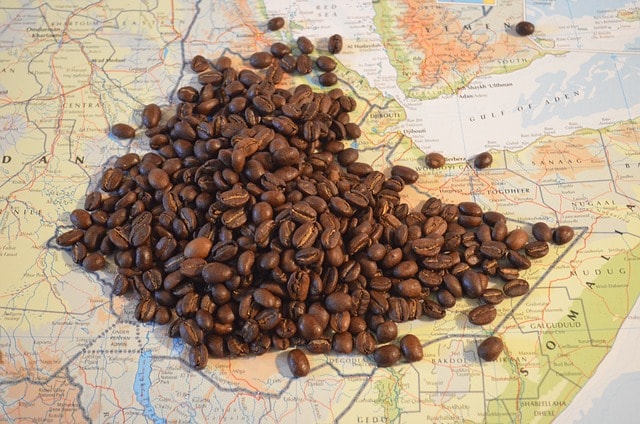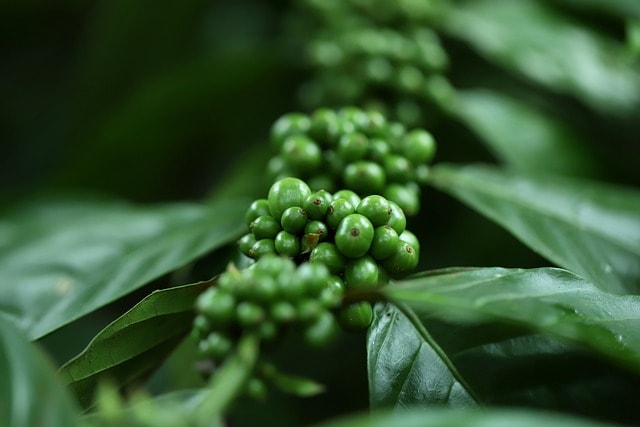Ethiopia coffee is famous for its unique flavors, deep-rooted history, and as a prime example of single origin coffee. Known as the birthplace of coffee, Ethiopia produces beans like fruity Yirgacheffe and chocolatey Sidamo. This article dives into what makes Ethiopia coffee special, covering its origins, regional varieties, and cultural significance.
Key Takeaways
- Ethiopia is recognized as the birthplace of coffee, boasting a rich cultural heritage and ideal climate for producing high-quality Arabica beans.
- Major coffee-growing regions in Ethiopia, including Yirgacheffe, Sidamo, and Harrar, each produce distinct flavor profiles that cater to a variety of tastes. Many of these distinct flavor profiles are a result of coffee being cultivated on small farms, which contribute to the unique characteristics of Ethiopian coffee.
- The establishment of cooperatives has empowered Ethiopian coffee farmers by improving pricing strategies and access to resources, enhancing both quality and sustainability.
Ethiopia: The Birthplace of Coffee

Ethiopia holds the distinguished title of the birthplace of coffee, with a history that stretches back to the 8th century. The legend of Kaldi, the goat herder who discovered coffee after noticing his goats becoming energized after eating coffee cherries, is a testament to the deep roots coffee has in Ethiopian culture. By the 1500s, coffee cultivation had become integral to Ethiopian life, setting the stage for the rich coffee culture that persists today.
Ethiopia’s climate perfectly suits Arabica coffee beans, with high altitudes, fertile soil, and consistent rainfall offering ideal conditions for high-quality production. This natural advantage, coupled with centuries of cultivation expertise, makes Ethiopian coffee beans highly sought after worldwide. The diverse microclimates and traditional processing methods in Ethiopia give rise to unique coffee flavors, from fruity and floral to spicy and chocolatey. Ethiopian coffee is often available as whole bean, allowing consumers to experience the full depth and variety of its flavors.
Ethiopian coffee transcends being merely a beverage; it is a crucial part of the social and cultural fabric. Traditional coffee ceremonies, featuring intricate preparation rituals, serve as a cornerstone of Ethiopian hospitality and community life. In Ethiopia, coffee is celebrated, making each cup a gateway to rich cultural heritage.
Ethiopian Coffee Growing Regions

The diverse landscapes of Ethiopia contribute to the distinct characteristics and fragrant aroma of its coffee. Sidamo, Yirgacheffe, and Harrar are the main coffee-growing regions, each offering beans with distinct flavor profiles catering to diverse palates.
Yirgacheffe
Yirgacheffe, located in southern Ethiopia, is renowned for its high-quality arabica beans that grow at altitudes of 2,000 meters and above. Renowned for fragrant aromas, chocolatey sweetness, and fruity undertones, Ethiopia Yirgacheffe coffee is a favorite among specialty drinkers.
The elevated terrain and ideal climate contribute to the robust taste and floral characteristics of Yirgacheffe coffee. Whether enjoyed as a light roast or brewed in a French press, the finest beans from Yirgacheffe offer a delightful coffee experience that is both complex and satisfying.
Sidamo
Sidamo, another prominent coffee region in southern Ethiopia, produces beans that are known for their full-bodied, sweet, and complex flavors. Coffee from this region is known for its vibrant, crisp acidity. It also has refined sweetness and floral and citrus notes, resulting in an elegant aftertaste.
Sidamo’s rich soil and favorable climate make its coffees stand out, gaining popularity among roasters and enthusiasts alike. The fruity and earthy flavors, sometimes with hints of blueberry, provide a delightful sensory experience that captures the essence of Ethiopian coffee.
Harrar
Harrar, one of Ethiopia’s oldest coffee regions, is known for its wild, fruity flavors and bright, jammy taste reminiscent of blackberry. Processed using the dry method, where cherries are sun-dried, Harrar coffee’s fruity and floral notes are enhanced.
The beans from Harrar are often categorized into longberry, shortberry, or mocha, each offering a unique taste profile. Harrar coffee’s distinctive flavors make it a preferred choice for espresso blends, adding heady, fruity notes to the overall experience.
Coffee Production Methods in Ethiopia
Ethiopian coffee production methods are pivotal in defining the flavor profiles of its beans. Traditionally processed using dry methods, Ethiopian coffee now sees a growing trend toward wet processing, making up over 50 percent of production.
These methods include natural and washed processing, each imparting unique characteristics to the final product.
Natural Processing
Natural processing, one of the oldest methods, involves sun-drying coffee cherries on raised beds. This method enhances the fruity flavors of the coffee, producing deeper berry and citrus notes that are highly prized by coffee connoisseurs.
This slow drying process allows the cherries’ sugars to impart flavors to the beans, creating a rich, complex taste. This method is particularly well-suited to the Ethiopian climate and contributes to the unique flavor profiles of Ethiopian coffees.
Washed Processing
Washed processing involves quickly removing the beans from cherries and subjecting them to multiple washes to eliminate impurities. Though it requires more water, this method produces cleaner flavors and enhances overall coffee quality.
Washed processing is becoming popular in Ethiopia for its control over flavor profiles, producing high-quality coffee that is clean, bright, and full of character.
Unique Flavors and Tasting Notes of Ethiopian Coffees

Ethiopian coffee is celebrated for its vibrant and diverse flavor profiles. With over a thousand varieties of coffee beans, each offering unique taste characteristics, Ethiopia stands out in the world of specialty coffee.
Typically, Ethiopian coffee features a medium to full body and bright acidity, often complemented by low acidity. It features a floral aroma with notes of berries and wine. Yirgacheffe coffee, for example, is often praised for its clean and vibrant flavors, while Sidamo coffee is known for its smooth and syrupy body.
Harrar coffee adds another dimension with wild and fruity notes, including flavors like blueberry, banana, and strawberry. The diverse tasting notes and aromatic qualities of Ethiopian coffee offer a delightful experience for any coffee lover, whether enjoyed as a pour-over or cold brew.
The Role of Cooperatives in Ethiopian Coffee Trade
The establishment of cooperatives has transformed Ethiopian coffee trade, empowering farmers and enhancing coffee quality. After the end of the Marxist dictatorship, cooperatives began to form, offering farmers better pricing strategies and access to technical support.
Cooperatives enable many farmers to negotiate better prices, often receiving premiums significantly above the market rate. Collective action within cooperatives has improved farmers’ livelihoods, allowing them to invest in their communities and enhance their quality of life.
Brewing Ethiopian Coffee

Brewing Ethiopian coffee at home offers a rewarding experience, letting you savor the rich and complex flavors of this specialty coffee. For a fuller-bodied coffee, the French press is an excellent choice. A coarser grind, a coffee-to-water ratio of 1:15, and a four-minute steep time enhance the rich, smooth body of Ethiopian Yirgacheffe coffee.
The AeroPress is another excellent tool for brewing Ethiopian coffee, especially for those who prefer a quick and convenient method. It highlights the bright acidity and clean flavors typical of Ethiopian coffee, making it perfect for busy mornings.
Cold brew is ideal for warm weather, capturing the fruity notes of Ethiopian beans. Steeping coarsely ground Yirgacheffe beans in cold water for 12-16 hours yields a smooth and naturally sweet drink. To try these methods at home, consider the Coopers Cask Coffee Ethiopian product.
Ethiopian Coffee and Sustainability

Ethiopian coffee is mainly cultivated by smallholder farmers under the shade of trees, supporting a sustainable ecosystem. The absence of harmful agrochemicals preserves biodiversity and protects the forested landscapes essential for coffee production.
Innovative practices like agroforestry and organic fertilizers are promoted to enhance soil quality and coffee yields. Cooperatives are vital in this sustainable approach, providing farmers with technical support and finance, improving coffee quality, and fostering community welfare.
Summary
Ethiopian coffee offers a rich tapestry of flavors and a deep cultural heritage that makes every cup a unique experience. From the historical significance and diverse growing regions to the sustainable practices and cooperative efforts, Ethiopian coffee stands out as a beacon of quality and tradition. Whether you brew it at home or subscribe to a delivery service, the journey through Ethiopian coffee is one of discovery and delight.


